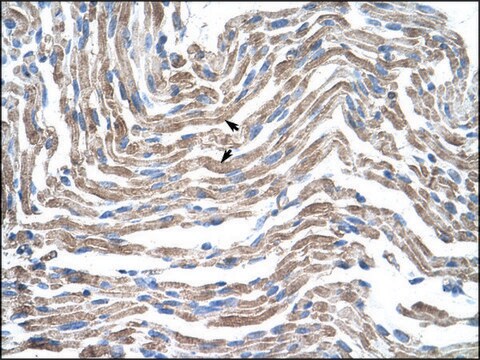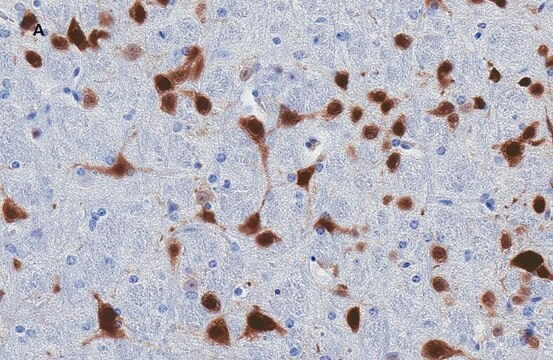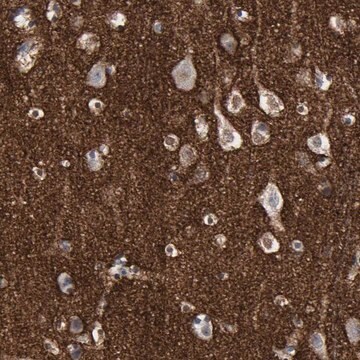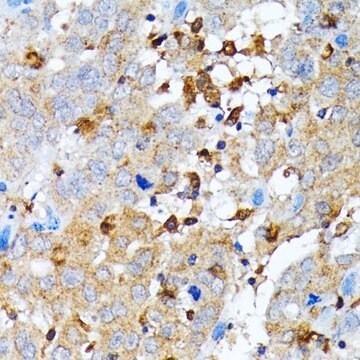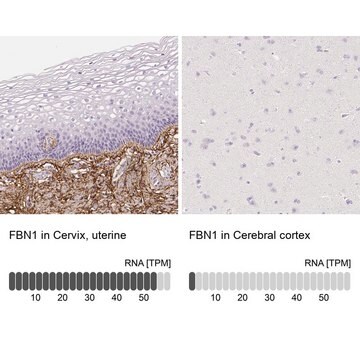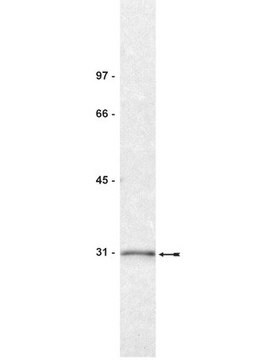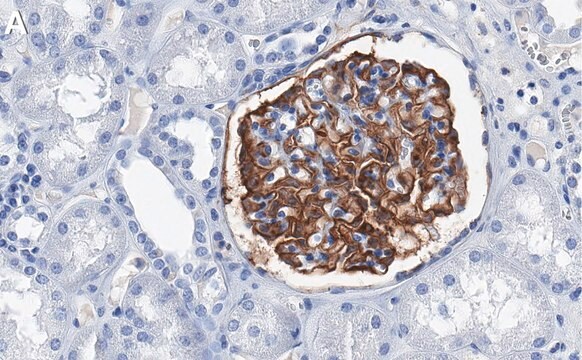추천 제품
생물학적 소스
mouse
Quality Level
결합
unconjugated
항체 형태
purified immunoglobulin
항체 생산 유형
primary antibodies
클론
3D2, monoclonal
양식
buffered aqueous solution
종 반응성
human
기술
immunohistochemistry (formalin-fixed, paraffin-embedded sections): suitable
indirect ELISA: suitable
western blot: 1-5 μg/mL
동형
IgG2aκ
GenBank 수납 번호
UniProt 수납 번호
배송 상태
dry ice
저장 온도
−20°C
타겟 번역 후 변형
unmodified
유전자 정보
human ... CASP1(834)
일반 설명
The caspase-1 (CASP1) /interleukin-1β converting enzyme (ICE) gene, with ten exons, is mapped to human chromosome 11q22.2. The encoded protein contains an N-terminal CARD (caspase activation and recruitment domain), a large P20 subunit and a small P10 subunit. CASP1 is distributed in leukocytes, monocytes and epithelial cells.
This gene encodes a protein which is a member of the cysteine-aspartic acid protease (caspase) family. Sequential activation of caspases plays a central role in the execution-phase of cell apoptosis. Caspases exist as inactive proenzymes which undergo proteolytic processing at conserved aspartic residues to produce 2 subunits, large and small, that dimerize to form the active enzyme. This gene was identified by its ability to proteolytically cleave and activate the inactive precursor of interleukin-1, a cytokine involved in the processes such as inflammation, septic shock, and wound healing. This gene has been shown to induce cell apoptosis and may function in various developmental stages. Studies of a similar gene in mouse suggest a role in the pathogenesis of Huntington disease. Alternative splicing of this gene results in five transcript variants encoding distinct isoforms. (provided by RefSeq)
면역원
CASP1 (AAH62327, 1 a.a. ~ 100 a.a) partial recombinant protein with GST tag. MW of the GST tag alone is 26 KDa.
Sequence
MADKVLKEKRKLFIRSMGEAPQAVQDNPAMPTSSGSEGNVKLCSLEEAQRIWKQKSAEIYPIMDKSSRTRLALIICNEEFDSIPRRTGAEVDITGMTMLL
Sequence
MADKVLKEKRKLFIRSMGEAPQAVQDNPAMPTSSGSEGNVKLCSLEEAQRIWKQKSAEIYPIMDKSSRTRLALIICNEEFDSIPRRTGAEVDITGMTMLL
생화학적/생리학적 작용
Caspase-1 has an ability to transform pro-inflammatory cytokines, interleukin-1 β (IL-1 β) and IL-18 into their active forms. In addition, it also participates in pyroptosis. Elevated expression of the gene has been observed in the aorta of coronary atherosclerosis patients. CASP1 helps in host cell survival by inducing membrane biogenesis to restore the impairment caused by pore-forming toxins.
물리적 형태
Solution in phosphate buffered saline, pH 7.4
법적 정보
GenBank is a registered trademark of United States Department of Health and Human Services
면책조항
Unless otherwise stated in our catalog or other company documentation accompanying the product(s), our products are intended for research use only and are not to be used for any other purpose, which includes but is not limited to, unauthorized commercial uses, in vitro diagnostic uses, ex vivo or in vivo therapeutic uses or any type of consumption or application to humans or animals.
적합한 제품을 찾을 수 없으신가요?
당사의 제품 선택기 도구.을(를) 시도해 보세요.
Storage Class Code
10 - Combustible liquids
Flash Point (°F)
Not applicable
Flash Point (°C)
Not applicable
개인 보호 장비
Eyeshields, Gloves, multi-purpose combination respirator cartridge (US)
가장 최신 버전 중 하나를 선택하세요:
Overexpression of caspase-1 in aorta of patients with coronary atherosclerosis.
Zheng F
Heart, Lung & Circulation, 23, 1070-1074 (2014)
CASP1 (caspase 1, apoptosis-related cysteine peptidase (interleukin 1, beta, convertase))
Kumar Y
Atlas of Genetics and Cytogenetics in Oncology and Haematology, 269-275 (2007)
Monocyte Caspase-1 Is Released in a Stable, Active High Molecular Weight Complex Distinct from the Unstable Cell Lysate-Activated Caspase-1.
Shamaa OR
PLoS ONE, 10 (2015)
Matija Hedl et al.
Proceedings of the National Academy of Sciences of the United States of America, 111(37), 13451-13456 (2014-09-10)
Inflammatory diseases are characterized by dysregulated cytokine production. Altered functions for most risk loci, including the inflammatory bowel disease and leprosy-associated tumor necrosis factor ligand superfamily member 15 (TNFSF15) region, are unclear. Regulation of pattern-recognition-receptor (PRR)-induced signaling and cytokines is
L Mortimer et al.
Mucosal immunology, 7(4), 829-841 (2013-11-21)
Entamoeba histolytica (Eh) is an extracellular protozoan parasite of the human colon, which occasionally breaches the intestinal barrier. Eradicating ameba that invades is essential for host survival. A defining but uncharacterized feature of amebic invasion is direct contact between ameba
자사의 과학자팀은 생명 과학, 재료 과학, 화학 합성, 크로마토그래피, 분석 및 기타 많은 영역을 포함한 모든 과학 분야에 경험이 있습니다..
고객지원팀으로 연락바랍니다.